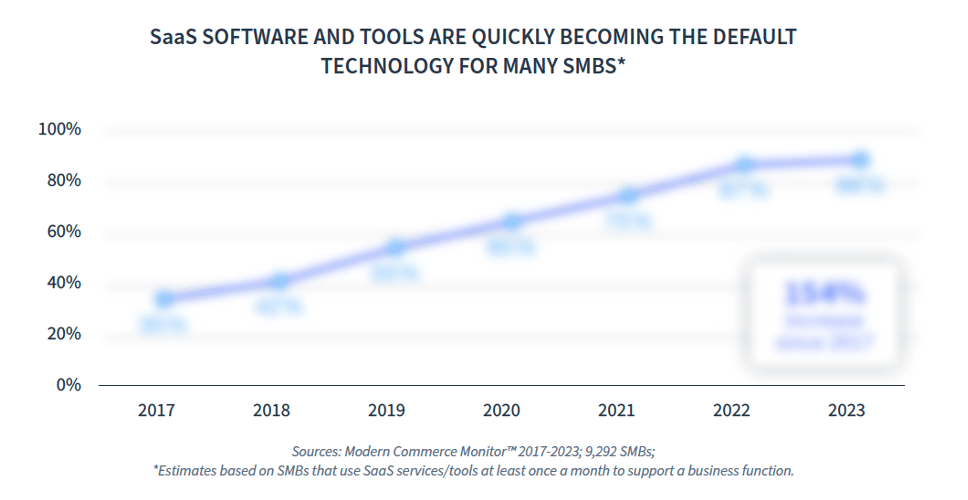As part of the ritual of examining local commerce and SMB Saas strategies, Localogy goes right to the source: SMBs themselves. How do they feel about marketing and operational software? What features do they want? And how has their hunger changed in a pandemic? This is all a moving target.
Localogy’s Modern Commerce Monitor (MCM) answers these and other questions across the SMB SaaS product set, which we preview in this Benchmark Bytes series. And starting today, we enter a new chapter of this series, with highlights from the latest wave (8.0) of Modern Commerce Monitor.
Starting at the top, we’ll tackle the most basic high-level finding in the study: how many SMBs use SaaS products to operate and market their businesses? Beyond the snapshot today, how is that trending and what does it say about the level of maturity in the SMB SaaS industry life cycle? Let’s dive in…
Data Dive
– SMB SaaS penetration now stands at 89 percent, up from 87 percent in 2022.
– This slight uptick follows a few years of ramping adoption growth. It grew 22 percentage points in 2 years… then just two points in the past year.
– This plateau could be due to a few factors
– For one, the Covid software boom bears out in these figures… as does the Covid hangover in the software world.
– After accelerated adoption, SMB needs are mostly met and they could be putting new adoption on hold for a while as they work with the tools they rapidly adopted in the Covid era.
– Beyond Covid or any other market factors, SMB adoption growth is approaching a natural ceiling, when it’s bound to decelerate.
– Regardless of the reason, slowing aggregate market growth means that growth for individual players could be harder to achieve. It could come from a few places.
– Growth can result from market share gains, meaning we’ll likely see market competition heat up in key SMB SaaS categories like fintech, CRM, eCommerce and sales & marketing.
– Growth can also result in increasing spend per SMB (ARPA). Though the number of SMBs adopting SaaS tools is slowing, their average spend levels can increase.
– Both of these measures will be the name of the game for SMB SaaS players in the near term.

Localogy members can access full charts and SMB survey reports. Non-members can purchase reports.
Long-Tail Opportunity
Stepping back, SMB online marketing – as well as operational and fintech tools – continues to grow rapidly. SMB SaaS startups and online services providers are correspondingly thriving as it continues to grow as a leading subsector of the broader SaaS universe. There’s a long-tail opportunity at play.
Meanwhile, new SMB SaaS users could represent permanent adopters – a concept that accelerated in the Covid era as SMBs were forced to boost their digital transformation. This sends them into the arms of SaaS providers to accomplish a range of marketing and operational functions.
We’ll return in the next installment to go deeper into Localogy original survey research. That will include SMB goals and success factors. Let us know what additional insights jump out at you from the above data, and stay tuned for more breakdowns in our Benchmark Bytes series.



